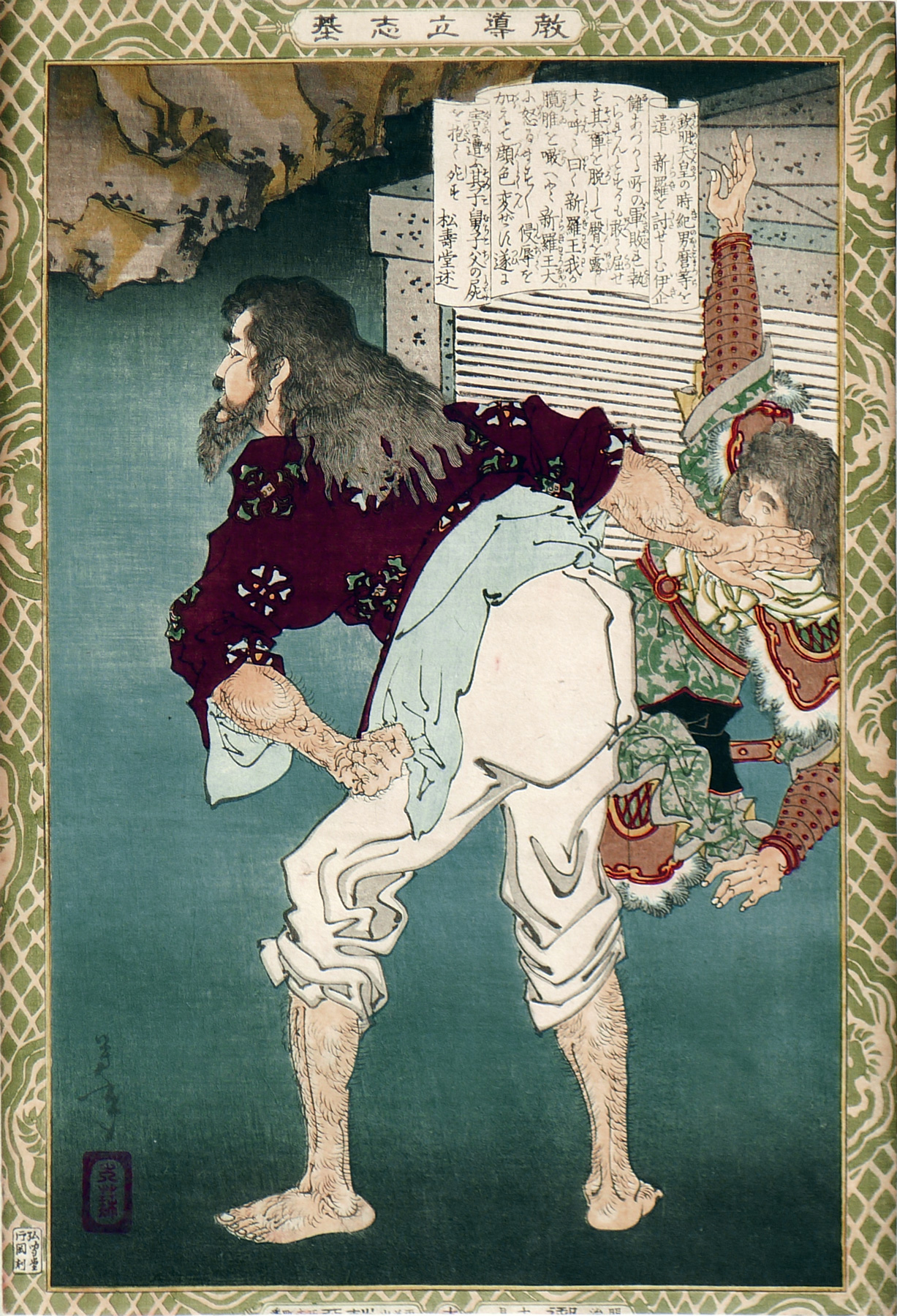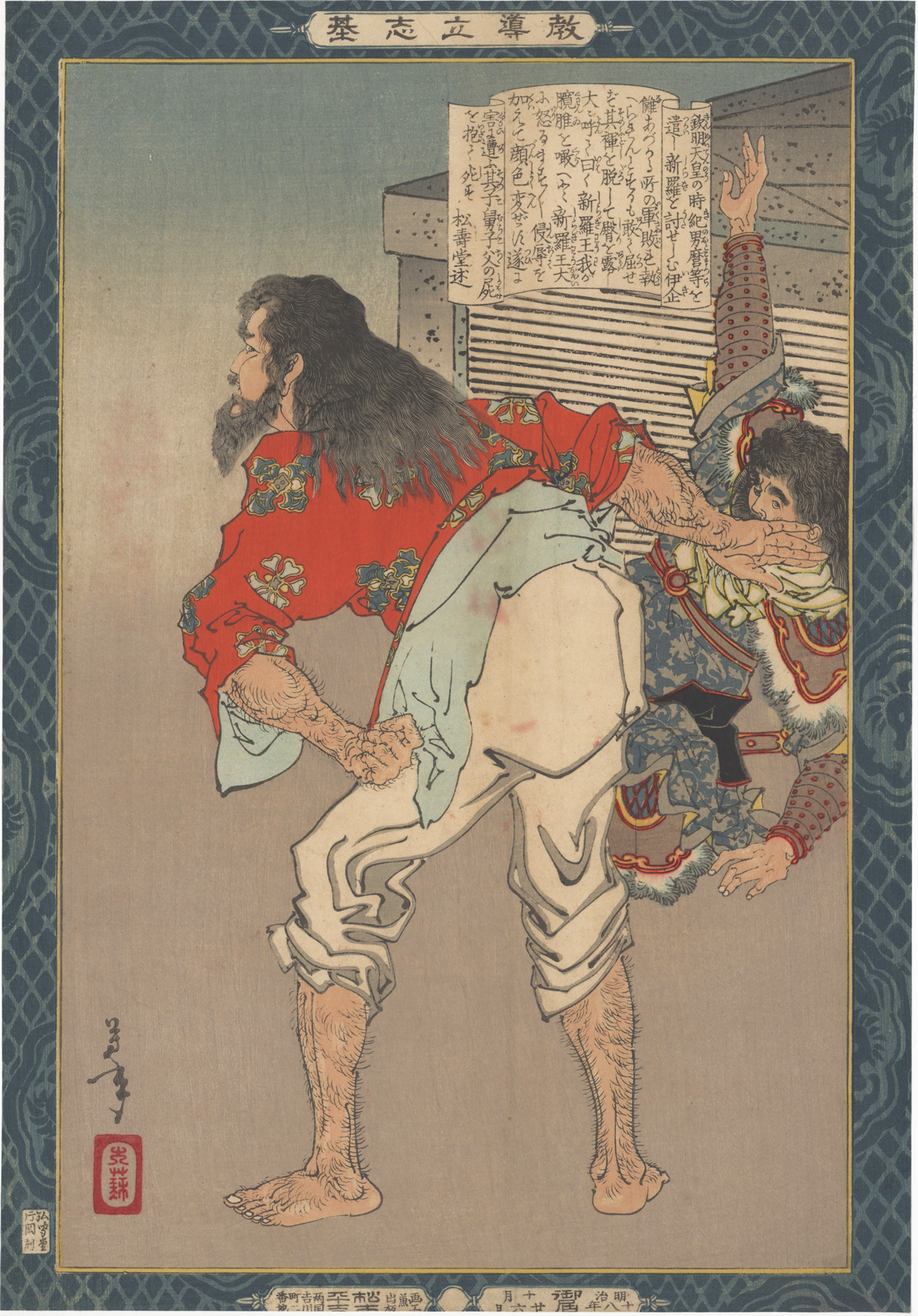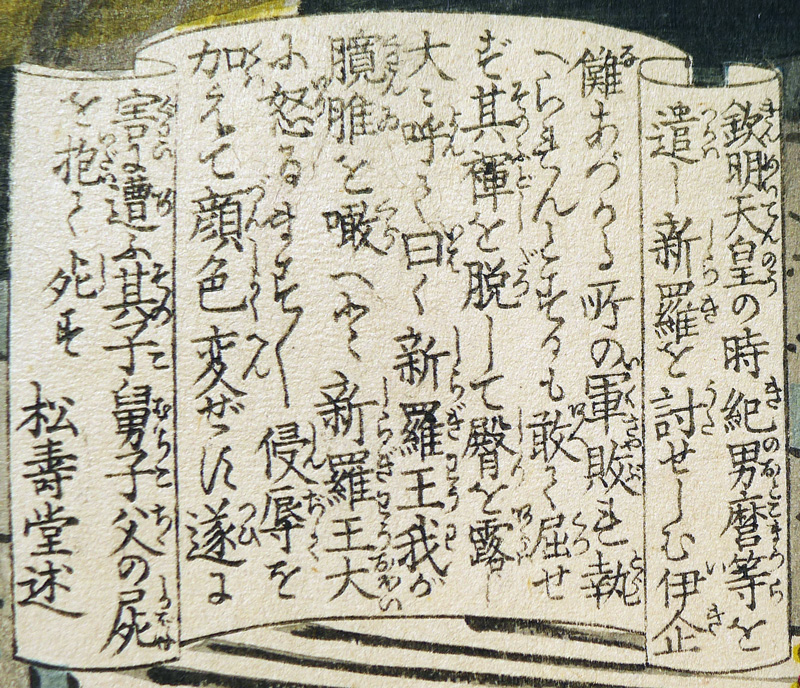About This Print
Two states of the first print1 (壹 ichi) in the series Instructive Models of Lofty Ambition picturing Tsuki no Kishi Ikina defying the Silla commander who has ordered him to take down his pants, point his buttocks toward Japan and shout "Japanese generals, bite my ass." Ikina's response is to shout "King of Silla, eat my ass!" shocking the Silla commander, seen on the ground, who orders Ikina's torture and death.Ikina is seen as an example of "obstinate courage."
Most notable, however, is not the change in color of the hakama but the presence of a large rock in the print shown above on the left and its absence in the print shown on the right. My guess is that the printing on the left is an earlier edition than the printing on the right, which also lacks the print number in the publisher's cartouche along the bottom margin. In comparing the two states IHL Cat. #921 is a more "deluxe" edition in terms of the printing effects employed.
2 http://members.jcom.home.ne.jp/yosha/nn/bibliography/Bibliography_drawings.html
3 Tsukioka Yoshitoshi no sekai (The World of Tsukioka Yoshitoshi), compiled by Yoshida Susugu, edited by Isao Toshihiko, Tokyo Shoseki, 1992.
The Story
Sources: A Waka Anthology: The Gem-Glistening Cup, Edwin A. Cranston, 1993, Stanford University Press, pgs. 3, 110-111 and a website of William Wetherall http://www.yoshabunko.com/history/Reports_from_early_records.html#562ikina
Background
The story of Ikina is told in the Nihonshoki ("Chronicles of Japan," completed in 720.) Silla was a long-lived kingdom (57 BC - 935 AD) occupying the east coast of modern day Korea that fought frequent battles with Japanese and Chinese armies who had off and on again alliances with other ancient Korean kingdoms, such as the Kaya Confederation. In 562 Silla had defeated the Kaya Confederation along with an expeditionary force sent from Japan.
The Incident
Tsuki no Kishi Ikina, who was taken prisoner at the same time, was a man of valiant and fiery character, and never submitted till the end. The Silla commander drew his sword and made as if to cut him down. He compelled Ikina to take off his trousers and then ordered him to point his buttocks toward Japan and shout in a loud voice, “Japanese generals, bite my ass!” But Ikina shouted, “King of Silla, eat my ass!” He kept shouting the same thing even though they tortured him, and so he was killed. His son Ojiko also died, holding his father in his arms. Ikina was always like this – no one could rob him of what he meant to say. Consequently, he alone was mourned by the other commanders. His wife Ōbako was captured with him. Grieving, she sang:
Karakuni no
Ki no e ni tachite
Ōbako wa
Hira furasu mo
Yamato e mikiteStanding atop
The fortress of Kara,
Ōbako
Waves her scarf
Toward Yamato
1 Ikina 伊企儺
教導立志基 壹 伊企儺 月岡芳年 1885年10月26日
Transcription:
“欽明天皇の時 紀男麿等を遣し新羅を討たせしむ 伊企儺あづかる所の軍敗れ執(とら)へられんとするも敢て屈せず其褌を脱して臀(尻)を露し大ニ呼で曰く新羅王我が臗?(月+隹)(くわんゐ)を噉(くら)へと新羅王大に怒るます/\侵辱を加えて顔色変ぜず遂に害に遭ふ其子舅子父の屍を抱て死す 松壽堂述”
The scroll begins "During the age of Emperor Kinmei..." [“欽明天皇の時]About The Series "Kyōdō risshi no motoi"
Notes:1. This series is variously translated as "Instructive Models of Lofty Ambition," "Foundations of Learning and Achievement," "Foundation of Instruction and Perseverance," "Self-Made Men Worthy of Emulation," "Paragons of Instruction and Success," "Moral of Success," "Examples of Self-Made Leaders," and "Instruction in the Fundamentals of Success." The title in Japanese is sometimes seen as "Kyōdō risshiki or "Kyōdō risshi no moto," in addition to the most commonly seen transliteration of "Kyōdō risshi no motoi".2. For a complete listing of all the prints in the series and additional information please see the article on this site titled Instructive Models of Lofty Ambition.
This series ran between October 1885 and November 1890 and featured a long list of heroes and heroines, from antiquity to contemporary times, who were regarded as standards of moral leadership and self-realization.
Source: Kiyochika Artist of Meiji Japan, Henry D. Smith II, Santa Barbara Museum of Art, 1988, p. 74-75; original research and as footnoted.
This series of 58 prints,1 plus a table of contents sheet (目録), were originally published between October 1885 and November 1890 by the Tokyo publisher Matsuki Heikichi 松木平吉.2 The table of contents sheet issued by the publisher states that "fifty prints make up the complete set (五十番揃)". Three prints not in the initial release were added over the five year publication period, as were five redesigns of original prints, eventually increasing the total print count to 58. The seven artists contributing prints were Kobayashi Kiyochika (1847-1915) [20 prints], Mizuno Toshikata (1866-1908) [16 prints], Inoue Tankei (Yasuji) (1864-1889) [13 prints], Taiso (Tsukioka) Yoshitoshi (1839-1892) [5 prints], Yōshū Chikanobu (1838-1912) [2 prints], Toyohara Kunichika (1835–1900) [1 print], and Hachisuka (Utagawa) Kuniaki II (1835-1888) [1 print]. All the artists, with the exception of Yōshū Chikanobu, are listed in the top scroll of the table of contents sheet. Various colors (including blue, blue/green, and tan/brown) were used for the decorative border, and in 1902 the series was re-issued by Matsuki without borders.
Brief texts contained within a scroll-like cartouche appearing on each print provide historical details. The scroll composer's name is given at the end of the scroll text. The “lofty ambition” of the title is a Confucian concept, originally from Mencius, meaning “righteous determination that would inspire others.” The market for the series probably included former samurai, ambitious youth, and conservative intellectuals.
"[W]hen it was completed in 1890 the publisher was singled out for special recognition by the government for having sponsored such noble subject matter."3
This series ran between October 1885 and November 1890 and featured a long list of heroes and heroines, from antiquity to contemporary times, who were regarded as standards of moral leadership and self-realization.
This series of 58 prints,1 plus a table of contents sheet (目録), were originally published between October 1885 and November 1890 by the Tokyo publisher Matsuki Heikichi 松木平吉.2 The table of contents sheet issued by the publisher states that "fifty prints make up the complete set (五十番揃)". Three prints not in the initial release were added over the five year publication period, as were five redesigns of original prints, eventually increasing the total print count to 58. The seven artists contributing prints were Kobayashi Kiyochika (1847-1915) [20 prints], Mizuno Toshikata (1866-1908) [16 prints], Inoue Tankei (Yasuji) (1864-1889) [13 prints], Taiso (Tsukioka) Yoshitoshi (1839-1892) [5 prints], Yōshū Chikanobu (1838-1912) [2 prints], Toyohara Kunichika (1835–1900) [1 print], and Hachisuka (Utagawa) Kuniaki II (1835-1888) [1 print]. All the artists, with the exception of Yōshū Chikanobu, are listed in the top scroll of the table of contents sheet. Various colors (including blue, blue/green, and tan/brown) were used for the decorative border, and in 1902 the series was re-issued by Matsuki without borders.
Brief texts contained within a scroll-like cartouche appearing on each print provide historical details. The scroll composer's name is given at the end of the scroll text. The “lofty ambition” of the title is a Confucian concept, originally from Mencius, meaning “righteous determination that would inspire others.” The market for the series probably included former samurai, ambitious youth, and conservative intellectuals.
"[W]hen it was completed in 1890 the publisher was singled out for special recognition by the government for having sponsored such noble subject matter."3
1 The Tokyo Metropolitan Library online collection shows 50 prints and a Table of Contents sheet. The Table of Contents lists the titles of 50 prints. Smith in Kiyochika Artist of Meiji Japan identified 52 prints. I have identified 58 prints from this series including five prints (Ikina, Michizane Sugiwara, Kesa Gozen, Soga Brothers and Hokiichi Hanawa) that were re-designed and re-printed, likely due to damaged or lost blocks.
2 Robert Schaap notes in Appendix II, p. 166 of Yoshitoshi, Masterpieces from the Ed Freis Collection, Chris Uhlenbeck and Amy Reigle Newland, Hotei Publishing, 2011 that the series originally appeared as newspaper supplements.
3 The World of the Meiji Print: Impressions of a New Civilization, Julia Meech-Pekarik, Weatherhill, 1986, p. 122.
1 The Tokyo Metropolitan Library online collection shows 50 prints and a Table of Contents sheet. The Table of Contents lists the titles of 50 prints. Smith in Kiyochika Artist of Meiji Japan identified 52 prints. I have identified 58 prints from this series including five prints (Ikina, Michizane Sugiwara, Kesa Gozen, Soga Brothers and Hokiichi Hanawa) that were re-designed and re-printed, likely due to damaged or lost blocks.
2 Robert Schaap notes in Appendix II, p. 166 of Yoshitoshi, Masterpieces from the Ed Freis Collection, Chris Uhlenbeck and Amy Reigle Newland, Hotei Publishing, 2011 that the series originally appeared as newspaper supplements.
3 The World of the Meiji Print: Impressions of a New Civilization, Julia Meech-Pekarik, Weatherhill, 1986, p. 122.
Print Details
| IHL Catalog | #921, #1265 | ||
| Title or Description | Ikina 伊企儺 | ||
| Series | “Instructive Models of Lofty Ambition” (Kyodo risshiki 教導立志基) [note: seriestitle also listed as 'Kyodo Risshi no Moto', ‘Kyodo risshi no motoi’,‘Kyōdō risshi ki’ and variously translated as “Moral of success” or“Foundations of learning and achievement” or “Self-made Men Worthy ofEmulation”' or “Examples of Self-made Leaders” or "Paragons of instruction and success"] | ||
| Artist | Tsukioka Yoshitoshi (1839-1892) | ||
| Signature | 芳年 Yoshitoshi
| ||
| Seal | 大蘇 Taiso (as shown above beneath signature) | ||
| Publication Date | October 26, 1885 御届明治十八年十月二十六日 | ||
| Publisher | Matsuki Heikichi (松木平吉) proprietor of Daikokuya Heikichi [Marks: seal not shown; pub. ref. 029] above: this print's trimmed cartouche below: the full cartouche from the Tokyo Metropolitan Library's Print click to enlarge IHL Cat. #1265 (later state) while publisher's information and publishing date remain unchanged, the print number in the series is absent. (from right to left) publishing and printing date: 明治十八年 御届 十月廿六日 [Meiji 18th year, notification delivered, 10th month 26th day] assigned number within series: 壹 [1] publisher information: 画工兼 出板 松木平吉 [in seal script] 両国吉川町二番地 [artist and publisher Ryōgoku Yoshikawachō 2-banchi Matsuki Heikichi han] | ||
| Carver | Kataoka 片岡 (Note: the Tokyo Metropolitan Library transcribes this cartouche as 弘聞堂片岡刻)
| ||
| Impression | IHL Cat. #921 - excellent; IHL Cat. #1265 - excellent | ||
| Colors | IHL Cat. #921 - excellent; IHL Cat. #1265 - excellent | ||
| Condition | IHL Cat. #921 good - bottom border trimmed; not backed IHL Cat. #1265 good - bottom border slightly trimmed; light backing; minor soiling | ||
| Genre | ukiyo-e; rishki-e; kyōiku nishiki-e | ||
| Miscellaneous | print number 1 (壹); position 1 in the Table of Contents for the series scroll text by 松寿堂述 (松壽堂 述) | ||
| Format | vertical oban | ||
| H x W Paper | IHL Cat. #921: 13 3/8 x 9 1/8 in. (34 x 23.2 cm) IHL Cat. #1265: 13 5/8 x 9 3/8 in. (34.6 x 23.8 cm) | ||
| Literature | Yoshitoshi, Masterpieces from the Ed Freis Collection, Chris Uhlenbeck and Amy Reigle Newland, Hotei Publishing, 2011, p. 166. | ||
| Collections This Print | The Tsubouchi Memorial Theatre Museum of Waseda University 401-0416; Tokyo Metropolitan Library 280-K9; Los Angeles County Museum of Art M.84.31.278; Ritsumeikan AcNo.Z0173-373; Worcester Museum of Art 2002.184 |







 IHL Cat. #921
IHL Cat. #921